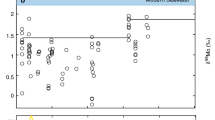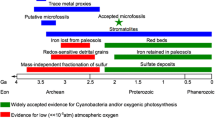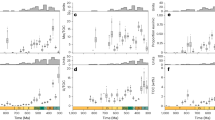Abstract
Geochemical approximation of Earth’s atmospheric O2 level over geologic time prompts hypotheses linking hyper- and hypoxic atmospheres to transformative events in the evolutionary history of the biosphere. Such correlations, however, remain problematic due to the relative imprecision of the timing and scope of oxygen change and the looseness of its overlay on the chronology of key biotic events such as radiations, evolutionary innovation, and extinctions. There are nevertheless general attributions of atmospheric oxygen concentration to key evolutionary changes among groups having a primary dependence upon oxygen diffusion for respiration. These include the occurrence of Devonian hypoxia and the accentuation of air-breathing dependence leading to the origin of vertebrate terrestriality, the occurrence of Carboniferous-Permian hyperoxia and the major radiation of early tetrapods and the origins of insect flight and gigantism, and the Mid-Late Permian oxygen decline accompanying the Permian extinction. However, because of variability between and error within different atmospheric models, there is little basis for postulating correlations outside the Late Paleozoic. Other problems arising in the correlation of paleo-oxygen with significant biological events include tendencies to ignore the role of blood pigment affinity modulation in maintaining homeostasis, the slow rates of O2 change that would have allowed for adaptation, and significant respiratory and circulatory modifications that can and do occur without changes in atmospheric oxygen. The purpose of this paper is thus to refocus thinking about basic questions central to the biological and physiological implications of O2 change over geological time.
Access this chapter
Tax calculation will be finalised at checkout
Purchases are for personal use only
Similar content being viewed by others
References
Azad P, Haddad GG. Survival in acute and severe low O2 environment: use of a genetic model system. Ann N Y Acad Sci. 2009;1177:39–47.
Bergman NM, Lenton TM, Watson AJ. COPSE: a new model of biogeochemical cycling over Phanerozoic time. Am J Sci. 2004;304:397–437.
Berkner LV, Marshall LC. On the origin and rise of oxygen concentration in the earth’s atmosphere. J Atmos Sci. 1965;22:225–61.
Berner RA. Phanerozoic atmospheric oxygen: new results using the GEOCARBSULF model. Am J Sci. 2009;309:603–6.
Berner RA, Canfield DE. A new model of atmospheric oxygen over Phanerozoic time. Am J Sci. 1989;289:333–61.
Berner RA, VandenBrooks JM, Ward PD. Oxygen and evolution. Science. 2007;316:557–8.
Carrier DR, Farmer CG. The evolution of pelvic aspiration in archosaurs. Paleobiology. 2000;26:271–93.
Carroll RL. Vertebrate paleontology and evolution. New York, NY: WH Freeman and Company; 1988. p. 698.
Cieri RL, Craven BA, Schachner ER, Farmer CG. New insight into the evolution of the vertebrate respiratory system and the discovery of unidirectional airflow in iguana lungs. Proc Natl Acad Sci U S A. 2014;111:17218–23.
Clack JA. Gaining ground: the origin and evolution of tetrapods. Bloomington, IN: Indiana University Press; 2002. p. 369.
Clapham ME, Karr JA. Environmental and biotic controls on the evolutionary history of insect body size. Proc Natl Acad Sci U S A. 2012;109:10927–30.
Clement AM, Long JA. Air-breathing adaptation in a marine Devonian lungfish. Biol Lett. 2010;6:509–12.
Cloud P. The biosphere. Sci Am. 1983;249:176–89.
Dahl TW, Hammarlund EU, Anbar AD, Bond DPG, Gill BC, Gordon GW, Knoll AH, Nielsen AT, Schovsbo NH, Canfield DE. Devonian rise in atmospheric oxygen correlated to the radiations of terrestrial plants and large predatory fish. Proc Natl Acad Sci U S A. 2010;107:17911–5.
Dudley R. Atmospheric oxygen, giant Paleozoic insects and the evolution of aerial locomotor performance. J Exp Biol. 1998;201:1043–50.
Dudley R. The evolutionary physiology of animal flight: paleobiological and present perspectives. Annu Rev Physiol. 2000;62:135–55.
Erwin DH. The great Paleozoic crisis: life and death in the Permian. New York, NY: Columbia University Press; 1993. p. 327.
Falkowski PG, Katz ME, Milligan AJ, Fennel K, Cramer BS, Aubry MP, Berner RA, Novacek MJ, Zapol WM. The rise of oxygen over the past 205 million years and the evolution of large placental mammals. Science. 2005;309:2202–4.
Farmer CG, Sanders K. Unidirectional airflow in the lungs of alligators. Science. 2010;327:338–40.
Feder ME. Integrating the ecology and physiology of plethodontid salamanders. Herpetologica. 1983;39:291–310.
Feder ME, Olsen LE. Behavioral and physiological correlates of recovery from exhaustion in the lungless salamander Batrachoseps attenuatus (Amphibia: Plethodontidae). J Comp Physiol. 1978;128:101–7.
Fitch WM, Langley CH. Protein evolution and molecular clock. Fed Proc. 1976;35:2092–7.
Flück M, Webster KA, Graham J, Giomi F, Gerlach F, Schmitz A. Co** with cyclic oxygen availability: evolutionary aspects. Integr Comp Biol. 2007;47:324–31.
Frazier MR, Woods HA, Harrison JF. Interactive effects of rearing temperature and oxygen on the development of Drosophila melanogaster. Physiol Biochem Zool. 2001;74:641–50.
Ghosh P, Garzione CN, Eiler JM. Rapid uplift of the Altiplano revealed through 13C-18O bonds in paleosol carbonates. Science. 2006;311:511–5.
Graham JB. Ecological and evolutionary aspects of integumentary respiration: body size, diffusion, and the invertebrate. Am Zool. 1988;28:1031–45.
Graham JB. Air-breathing fishes: evolution, diversity, and adaptation. San Diego, CA: Academic; 1997. p. 299.
Graham JB, Wegner NC. Breathing air in water and in air: the air-breathing fishes. In: Nilsson GE, editor. Respiratory physiology of vertebrates: life with and without oxygen. Cambridge: Cambridge University Press; 2010. p. 174–221.
Graham JB, Aguilar N, Dudley R, Gans C. The late Paleozoic atmosphere and the ecological and evolutionary physiology of tetrapods. In: Sumida SS, Martin KLM, editors. Amniote origins. San Diego, CA: Academic; 1997. p. 141–68.
Graham JB, Dudley R, Aguilar NM, Gans C. Implications of the late Palaeozoic oxygen pulse for physiology and evolution. Nature. 1995;375:117–20.
Graham JB, Wegner NC, Miller LA, Jew CJ, Lai NC, Berquist RM, Frank LR, Long JA. Spiracular air breathing in polypterid fishes and its implications for aerial respiration in stem tetrapods. Nat Commun. 2014;5:3022. doi:10.1038/ncomms4022.
Harrison JF, Lighton JRB. Oxygen-sensitive flight metabolism in the dragonfly Erythemis simplicicollis. J Exp Biol. 1998;201:1739–44.
Harrison JF, Kaiser A, VandenBrooks JM. Atmospheric oxygen level and the evolution of insect body size. Proc R Soc Lond B Biol Sci. 2010;277:1937–46.
Hemmingsen EA. Respiratory and cardiovascular adaptation in hemoglobin-free fish: resolved and unresolved problems. In: di Prisco G, Maresca B, Tota B, editors. Biology of Antarctic fish. New York, NY: Springer; 1991. p. 191–203.
Huey RB, Ward PD. Hypoxia, global warming, and terrestrial late Permian extinctions. Science. 2005;308:398–401.
Ishimatsu A, Graham JB. Roles of environmental cues for embryonic incubation and hatching in mudskippers. Integr Comp Biol. 2011;51:38–48.
Ishimatsu A, Hishida Y, Takita YT, Kanda T, Oikawa S, Takeda T, Huat KK. Mudskippers store air in their burrows. Nature. 1998;391:237–8.
Ishimatsu A, Aguilar NM, Ogawa K, Hishida Y, Takeda T, Oikawa S, Kanda T, Huat KK. Arterial blood gas levels and cardiovascular function during varying environmental conditions in a mudskipper, Periophthalmodon schlosseri. J Exp Biol. 1999;202:1753–62.
Jessen TH, Weber RE, Fermi G, Tame J, Braunitzer G. Adaptation of bird hemoglobins to high altitudes: demonstration of molecular mechanisms by protein engineering. Proc Natl Acad Sci. 1991;88:6519–22.
Jew CJ, Wegner NC, Yanagitsuru Y, Tresguerres M, Graham JB. Atmospheric oxygen levels affect mudskipper terrestrial performance: implications for early tetrapods. Integr Comp Biol. 2013;53:248–57.
Kawano SM, Blob RW. Propulsive forces of mudskipper fins and salamander limbs during terrestrial locomotion: implications for the invasion of land. Integr Comp Biol. 2013;53:283–94.
Klok CJ, Harrison JF. Atmospheric hypoxia limits selection for large body size in insects. PLoS One. 2009;4:e3876.
O’Connor PM, Claessens LPAM. Basic pulmonary design and flow-through ventilation in non-avian theropod dinosaurs. Nature. 2005;436:253–6.
Owerkowicz T, Elsey RM, Hicks JW. Atmospheric oxygen level affects growth trajectory, cardiopulmonary allometry and metabolic rate in the American alligator (Alligator mississippiensis). J Exp Biol. 2009;212:1237–47.
Pierce SE, Hutchinson JR, Clack JA. Historical perspectives on the evolution of tetrapodomorph movement. Integr Comp Biol. 2013;53:209–23.
Porteus C, Hedrick MS, Hicks JW, Wang T, Milsom WK. Time domains of the hypoxic ventilatory response in ectothermic vertebrates. J Comp Physiol B. 2011;181:311–33.
Powell FL. Studying biological responses to global change in atmospheric oxygen. Respir Physiol Neurobiol. 2010;173S:S6–12.
Schachner ER, Cieri RL, Butler JP, Farmer CG. Unidirectional pulmonary airflow patterns in the savannah monitor lizard. Nature. 2014;506:367–70.
Schidlowski M. Probleme der atmosphärischen Evolution im Präkambrium. Geol Rundsch. 1971;60:1351–84.
Shubin N. Your inner fish: a journey into the 35-billion-year history of the human body. New York, NY: Random House; 2008. p. 229.
Sidell BD, O’Brien KM. When bad things happen to good fish: the loss of hemoglobin and myoglobin expression in Antarctic icefishes. J Exp Biol. 2006;209:1791–802.
Storz JF, Runck AM, Moriyama H, Weber RE, Fago A. Genetic differences in hemoglobin function between highland and lowland deer mice. J Exp Biol. 2010;213:2565–74.
Takeda T, Ishimatsu A, Oikawa S, Kanda T, Hishida Y, Khoo KH. Mudskipper Periophthalmodon schlosseri can repay oxygen debts in air but not in water. J Exp Zool. 1999;284:265–70.
Van Voorhies WA. Metabolic function in Drosophila melanogaster in response to hypoxia and 100% oxygen. J Exp Biol. 2009;212:3132–41.
Van Voorhies WA, Ward S. The response of the nematode Caenorhabditis elegans to varied oxygen tensions. J Exp Biol. 2000;203:2467–78.
Vieites DR, Min M-S, Wake DB. Rapid diversification and dispersal during periods of global warming by plethodontid salamanders. Proc Natl Acad Sci U S A. 2007;104:19903–7.
Ward PD. Out of thin air: dinosaurs, birds, and Earth’s early atmosphere. Washington, DC: John Henry Press; 2006. p. 282.
Wedel MJ. Origin of postcranial skeletal pneumaticity in dinosaurs. Integr Zool. 2006;2:80–5.
Acknowledgments
The authors thank W. Milsom, J. Harrison, and R. Roach for their comments on this manuscript and their help with its presentation at the 2011 International Hypoxia Symposium. N.C. Wegner and C.J. Jew were supported by NSF grants IOS-0922569 and IOS-0817774 during the writing of this paper.
Author information
Authors and Affiliations
Corresponding author
Editor information
Editors and Affiliations
Rights and permissions
Copyright information
© 2016 Springer Science+Business Media New York
About this chapter
Cite this chapter
Graham, J.B., Jew, C.J., Wegner, N.C. (2016). Modeling Variable Phanerozoic Oxygen Effects on Physiology and Evolution. In: Roach, R., Hackett, P., Wagner, P. (eds) Hypoxia. Advances in Experimental Medicine and Biology, vol 903. Springer, Boston, MA. https://doi.org/10.1007/978-1-4899-7678-9_27
Download citation
DOI: https://doi.org/10.1007/978-1-4899-7678-9_27
Published:
Publisher Name: Springer, Boston, MA
Print ISBN: 978-1-4899-7676-5
Online ISBN: 978-1-4899-7678-9
eBook Packages: Biomedical and Life SciencesBiomedical and Life Sciences (R0)




